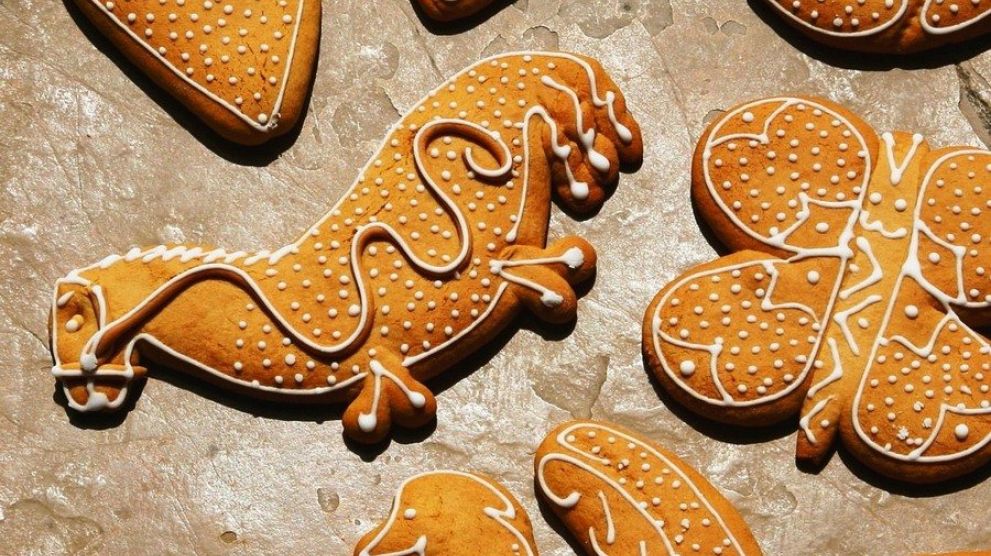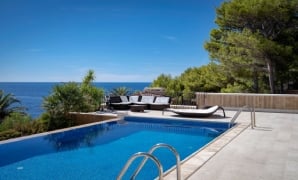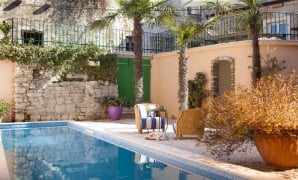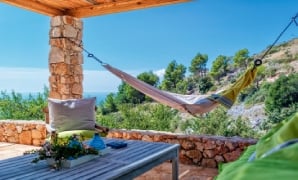A Perfect Gastro Experience
You don’t need to be a hard-bitten foodie to fall madly in love in Hvar cuisine. You don't need to be particularly adventurous or daring. The single prerequisite for enjoyment is you being there. Everything else will fall into place naturally.
Nowhere in Croatia is a cult of fine eats stronger than on this deviously delicious island. It has always been so. Ancient Greeks knew it when they inhabited Hvar. When Romans learned of it, they promptly invaded and conquered the island (there may have been other reasons in play but still). Venetians certainly knew it, when they moved in to plant the golden lion banner. So did the Austrians, Italians and, of course, us Croatians. Now you have the chance to get to know it. So, gentle traveler, visit soon. Eat copiously. Dream furiously.
Welcome to the center of Croatian gastronomy. There are no McDonald’s restaurants here. Instead, there are these dazzling dishes of distinct delight:
PEKA (UNDER THE BELL)
Shimmering afternoon heat begins to relent as the evening approaches but the sun is still fierce. A group of four sit around the old hardwood table, shaded from its fury by a lush vine pergola. They are sipping the fig grappa, immersed in a lively card game. The terrace rings with laughter, frequently broken by a bout of imaginative cursing as the fortunes in the game turn.
A fifth man, aproned, stands beside an ancient-looking bread oven. His caring gaze is fixed on a bell-shaped cast iron vessel covered in glowing birch-wood embers.
The smell promises utter deliciousness of the meal slowly cooking inside. It is bound to be distracting to the players, yet no one minds. Anyone who has had the good fortune to taste it knows that in another half hour or so, the feast of pure delight will have been served.
Peka is the epitome of slow cooking. Juicy succulence embodied. A feast of enticing flavors. Tenderness surpassing even the sous-vide shenanigans of our modern times.
Before the invention of the stove, Peka was a common sight on the fireplaces in homes and in taverns along the Croatian coastline. Today it is a delicacy worth the time and the effort it takes to prepare.
The process has been refined to the tiniest of details, with even the choice of firewood carefully thought out.
The bell itself is made from cast iron (best for meat and seafood) or clay (best for baking bread). The dish is placed on a platter, covered with the bell and in turn covered by beech, vine, and sometimes hornbeam embers.
There are many, many recipes for Peka dishes made with lamb, veal, fish, and octopus. It can be used to make fantastic bread as well. A typical Peka is made with a combination of meat or seafood, accompanied by potatoes and various veggies according to preference (just make sure not to use softer vegetable types, as they don’t work well in this ensemble). Everything is doused in copious amounts of white wine, Prošek, and olive oil and baked until the juices thicken and the ingredients become melt-in-the-mouth tender, typically for two to two and a half hours.
GREGADA
Each household on Hvar jealously guards their own secret Gregada recipe. It is passed down from mothers to daughters, generation to generation, constantly evolving yet keeping its ancient spirit.
Gregada was once upon a time a peasant dish, conveniently combining soup and the main course on one plate. Just another proof that simple, humble origin does not equal bland or tasteless. Quite the contrary. Each spoonful of Gregada will make your taste buds sing and bring a smile to your face.
Traditional Gregada is made with white fish too small to be put on grill, potatoes, and onions, thickened with a sauce of white wine with parsley, garlic, and celery root.
This tasty base can be refined in many ways. The most common additions are anchovies, high-quality white fish, rosemary, squid, scampi, and altered wine to water ratio in the stew.
It can be as simple or as complex as the situation requires. The basic ingredients are finely balanced and additions enhance the flavor, transforming the dish in the chef’s desired direction.
It is said that the fish of Hvar swims three times. First in the sea, then in olive oil, and finally in wine.
No matter the recipe, three rules must always be obeyed. First, never use tomatoes to prepare Gregada. Second — do not "kill" the fish with spices. Go gently and enjoy the superb taste of freshly caught Adriatic fish. Third — In the best British superspy fashion, just shake Gregada from time to time while cooking, never stir it.
KOLAČ SA KALOBEROM (CAROB CAKE)
No royal feast is complete without an appearance from a king. This particular monarch of a sweet tooth and gentle demeanor rose from the ranks of small-folk to reach a revered position at the dining table.
Carobs, aromatic and fragrant ingredients of this extraordinary cake have always been a Hvar staple. Taking their place among the agricultural trinity completed by olives and grapes, carob trees could be seen dotting the measured rectangle plots of Stari Grad Plain since ancient times.
Heavy, rich sponge, livened up by lemon juice, and sweetened to perfection by addition of a juicy fig or two makes the base, while a ganache glaze makes the magic truly come to life.
Round off your next dining experience with a slice of carob cake. Paired with a suitably decadent dessert wine, like the local Prošek, it will ease you into a mode of blissful satisfaction.
PAPRENJAK
During your time on the island, you are bound to come across these beautifully ornamented cookies. Horses, amphorae, butterflies, 4 leaf clovers and many more distinct shapes, dotted with a specially made icing, just beckon the weary and peckish traveler.
The birthplace of the delicious treat is the town of Stari Grad. Indeed, nothing says Stari grad quite like a Paprenjak. If you wish to keep the memory of your trip alive, you could pick up a beautiful, albeit inedible version as a souvenir that will always look good and will never go bad.
In contemporary Croatian language, the word paprenjak means a pepper cookie. However, in Hvarski paprenjak, there is no trace of pepper. Instead, the word papor denotes a certain kind of spice mix used in the batter, which gives the cookie its distinct taste.
As a cookie with a long history, Paprenjak was always a prized treat and for a good reason. It refused to go stale for days. It tasted like home. It was a welcome addition to any feast, in fact, a wedding without the platter or three of piping hot Paprenjaks was unimaginable. It was a perfect gift from home to a family member living abroad.
Paprenjak also served as an accurate, crumbly barometer — hardening up just before bura wind, and softening up before a bout of rain.
Some rules must be followed if you want your Paprenjak made properly, like preparing the batter for the cookie at least a day in advance. If you want to make it like a boss, toss the cookie cutter and form the intricate shapes by hand. Keep the old pastry bag in the drawer while you’re at it, and dot the cookie using a vine branch with a pin, like they in the olden days.
These are just some of the more famous dishes you should try during your stay, but the list is far from complete. We encourage you to explore as many charming restaurants as you can and experience all the wonders of the island cuisine.
DO IT YOURSELF
If you ever develop a serious craving for some original spiza (dishes) of Hvar, that is perfectly fine. We know of a way for you to seize the opportunity and learn the secrets of its preparation.
Villas Hvar has partnered with chefs that would be happy to teach you during one of the cook along sessions. Just contact us to arrange a delicious education. Feel free to show off your newly gained mad skills afterward.
*Author - Filip Šibl
*Photo Source - http://blog.vecernji.hr/veljko-barbieri




